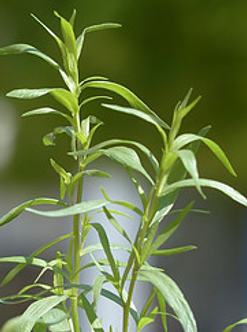
I have used tarragon for all my adult life. The aroma is wonderful and it adds a specific sweet flavor to your favorite dishes. I especially like adding tarragon to chicken soup. One can describe it’s aroma as almost licorice-like, similar to anise. Read on to learn how to grow a tarragon plant and see all it’s unusual uses. Tarragon is truly an international herb.
(Some of the links within this post are affiliate links on which I receive a small compensation from the sale of certain items.)
(As an Amazon Associate I earn from qualifying purchases.)
A Little Info About Tarragon
Tarragon has only been cultivated for around 600 years. Historians believe it was brought to Italy by invading Mongols who used it as a sleeping aid, breath freshener and for seasoning. After St. Catherine of France visited Pope Clemente VI in the fourteenth century, she was believed to have brought the herb back to France.
There are basically 2 varieties of tarragon, French and Russian.
French Tarragon
French tarragon, (Click and Gro) Artemisia dracunculus, is typically used in Western cuisine, namely French, English and American. It is indigenous to western Asia and Russia.
It has a sweet anise flavor. The flavor can be overwhelming, so it is advised to use it sparingly. You can always add more as you prepare your favorite recipe.
This is more popular than the Russian variety and is most likely the tarragon you purchase dried or as a plant.
French tarragon grows to 24 inches high and 2 feet wide within 2 years. It’s leaves are around 2 inches long and narrow, and have a nice green color. It’s flower is not too impressive also being green, and it is sterile, meaning it does not produce seeds.
Russian Tarragon
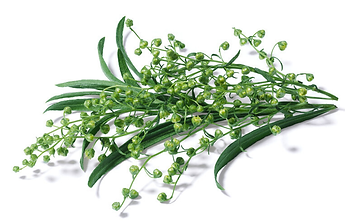
Russian tarragon, the little dragon of the garden, is a member of the Asteraceae family, including daisies, asters and sunflowers. It is called snake herb or dragon blood in the Netherlands and dragon mugwort in China.
This tarragon has these names because Its roots resemble snakes, and ancient folklore says it is the ruin of dragons and snakes alike.
Russian tarragon, Artemisia dracunculoides (Pursch), is not as flavorful as French tarragon. It is also more vigorous than the French variety, growing to a height of 5 feet. The color of the plant is a more pale green than the French variety.
It is sometimes referred to as the imposter tarragon because it is not as tasty as the French variety. The Russian variety has only a slight flavor, not as potent as French tarragon.
It is native to Siberia but also grows prolifically throughout the United States.
The Russian tarragon can be grown as an ornamental plant. It’s appearance is a lot more delicate than its counterpart, with long, attractive, beautiful green and flowing leaves. It’s flower forms in tiny clusters of 40 along a long bobbing stem and is yellowish-green.
Mexican Marigold Mint – The Faux Tarragon
This mint is sometimes referred to as a variety of tarragon. However, it is not in the same family. It has a similar aroma and flavor to French tarragon, both being anise or licorice-like. This herb is grown in the southern dry areas of the United States and is usually a substitute for French tarragon.
How to Grow Tarragon
There are a few ways to grow tarragon, from cuttings, seeds, or small plants, and by root division of large plants. I am going to focus on French tarragon in this article since that is the most flavorful and useful in recipes.
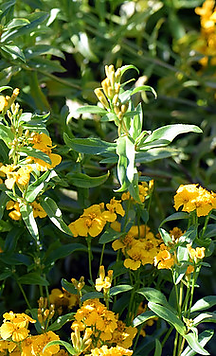
Seeds
Since French tarragon’s flowers are sterile, (they do not produce seeds), you cannot grow it this way.
If you would like the beauty of the Russian tarragon, it can be grown from seeds. (Click and Grow) Place the seeds in peat pods 1/16 of an inch down or directly on top of the surface. Keep moist with a sprayer and in a sunny location. Once the last threat of frost has passed, place them outside for a week to “harden off” (get used to an outdoor environment). Then plant in the ground at the depth of the peat pod and about 18 to 24 inches apart .
Cuttings
For best results, take the cuttings from a young plant.
Cut the stem of the plant 6 to 8 inches from the top. Remove the lower leaves. Dip the end of the stem in rooting hormone. Rather than using rooting hormone, you can try dipping it in organic honey, which has been used as a substitute for rooting hormones. Then place the cutting in moist potting soil.
Tarragon is also easy to propagate in water. After you have cut the stem and removed the bottom leaves, place it in water. Refer to my blog “How to Grow Oregano” under the topic of cuttings and follow the same directions.
Small Plants
Once the plants have either grown to 5 or 6 inches in the soil or formed a good amount of root in the water, transplant them to well drained, fertile soil. They can be planted directly into the ground or into a pot.
Fertilize the plant in its young stage of the plant and then stop. Too much fertilizer will cause the plant to be less flavorful.
Root Division Technique
Divide your plant when it becomes very thick. Sometimes the perennial will hollow out in the center. When this occurs you definitely need to divide the plant.
This division of a perennial plant can be done in early spring when shoots are about 4 to 5 inches high or in late fall after the growing season is complete.
Before dividing, prepare the area where you will transplant the plant. Dig the hole deep enough so the bottom of the stems when planted will meet the ground level. Amend the soil by adding some organic product into the soil and mix together.
Dig the entire plant out by cutting straight down 5 inches beyond the perimeter of the plant with a sharp spade shovel. Be sure to dig deep enough because the root system is very snake-like and deep. Once the plant is removed, gently cut the root system into parts with sharp, clean garden scissors or a garden fork. Very carefully remove the excess soil so you do not damage the root system.
Place your extra plant into the hole you just prepared and replace the surrounding soil. Water thoroughly. Keep watering 2 to 3 times per week so the root system takes hold. You can then plant the other plant back into the hole from which you removed the original plant. Remember to add some organic soil into the hole to give it a good start.
Tarragon Tips
Tarragon plants like full to partial sun. Once established they do well in dry conditions and will also tolerate poorer, sandy soil that is less fertile.
Keep them moist while they are young, but after a month or so water once or twice a week. Do not overwater as this will decrease their growth and flavor.
These plants thrive well in temperate zones with springlike temperatures, but do not like strong, intense, overly hot regions.
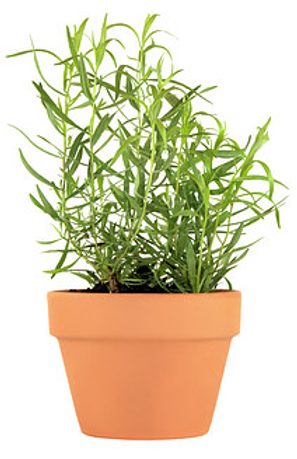
Tarragon can be grown in pots, (Amazon: Raised Planter Box) but make sure you have a large pot. The roots are serpentine like and grow rapidly. After 2 to 3 years you will have to transplant it into the ground.
This herb will survive winters in zones 4 or warmer. If your plant is in the ground, be sure to cover the roots with mulch after cutting it back in the fall. This will help ensure warm and cozy roots throughout the cold season.
When tarragon leaves are yellow or brown and crisp, water the plant more frequently. This usually occurs during droughts or in extremely hot weather.
When the leaves are soft and soggy, you have watered it too much.
Tarragon has its own kind of fungus called tarragon rust. To prevent the fungus from growing, space your plants at least 18 inches apart and water into the soil at ground level, not onto the leaves.
Harvesting Tarragon
Harvesting tarragon is easy. Tarragon can be harvested May through August. It’s best to harvest the new growth. Wait until your plant stems are 6 inches long. Pinch the top 3 inches since the new growth is much more tasty. You can either pinch the stem with your fingers or cut them with sharp kitchen scissors.
By pinching the top of the stems you will be promoting new growth and creating a more bushy plant.
Once harvested you can use them fresh or dry the leaves. Here is a technique for drying leaves.
- Cut your stems mid-morning and allow the dew to dry naturally from the leaves.
- Shake out the leaves to remove any insects; DO NOT WASH THE LEAVES
- Remove any brown, yellow, diseased, or dead leaves
- Gently pat any excess moisture dry with a paper towel
- Strip the leaves from the bottom 1 inch of the stem; save the leaves
- Tie the ends of 5 or 6 stems together with twine
- Punch about 20 airholes in a brown paper bag
- Place the stems along with the extra leaves in the bag upside down, tying the ends of the stems within the open part of the bag tightly with a tie
- Hang upside down in a warm airy room, but without much humidity
Once the leaves are dry secure them in an airtight container for up to 1 year. Place them in a cool dry place. When you wish to use the herb, pull off the leaves. One teaspoon of dried leaves is equivalent to one tablespoon of fresh leaves.
Some Uses of Tarragon
Culinary Delights
Tarragon is used throughout the world to season many kinds of meats such as chicken, veal (although I am not a proponent of this because of the harsh way the calves are treated), rabbit, and some fish, like salmon.
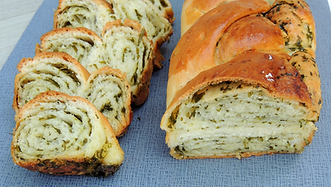
This herb is a great companion with thyme, mint, basil, parsley, chives, and dill, just to name a few.
Tarragon is also used in mostly all types of sauces like pesto and aioli. You can also use it in salad dressings and Bearnaise sauce, and can be used to create savory breads.
Before baking your favorite bread recipe, why not add some tarragon to the batter to spice it up?
I personally add tarragon to roasted chicken and chicken soup. Below is a recipe for chicken soup.
Easy Chicken Soup Recipe
Ingredients:
- 1 cooked chicken breast and/or 1 to 2 thighs shredded with a fork
- 1 large container of College Inn chicken broth or the broth of your choice; these come fat free, reduced sodium, or all natural
- 1/4 pound small pasta such as Orzo or Elbow
- 2 large carrots cut into bite sized pieces
- 1 celery stalk diced
- 1/2 a medium onion diced
- 1 to 2 tablespoons of olive oil
- 1 heaping tablespoon of tarragon(dried)
- 1 heaping tablespoon of parsley (dried)
- 1/4 tsp of pepper
Directions:
- pour olive oil into large pot
- saute onions in olive oil until they become clear
- add chicken broth, tarragon, parsley and pepper
- bring to a boil
- add shredded chicken, celery and carrots
- bring to a low boil and cook for 45 minutes
- serve in bowls with warm fresh bread
Medicinal Purposes
Tarragon, like many other herbs, is used in many cultures to remedy certain maladies, although it has not been medically proven to cure these ailments.
Here is a list of what tarragon has been used for to maintain a healthier body.
- stomach aches; indigestion
- vomiting and nausea after surgery
- reduce inflammation
- regulate blood sugar levels
- toothaches
- sleep problems
I’m sure many “healers” still believe tarragon can address these problems. However, check with your doctor before using tarragon for medicinal purposes.
Tasty Tarragon
As you can see there are many reasons to grow tarragon in your garden. Follow these instructions for cultivating the herb and you can’t go wrong! I’ve also included some places to buy herbs and accessories for growing herbs inside.

I hope you’ve enjoyed my article. Please leave a comment below. I’d love to hear from you.
Happy Gardening!
Nina

